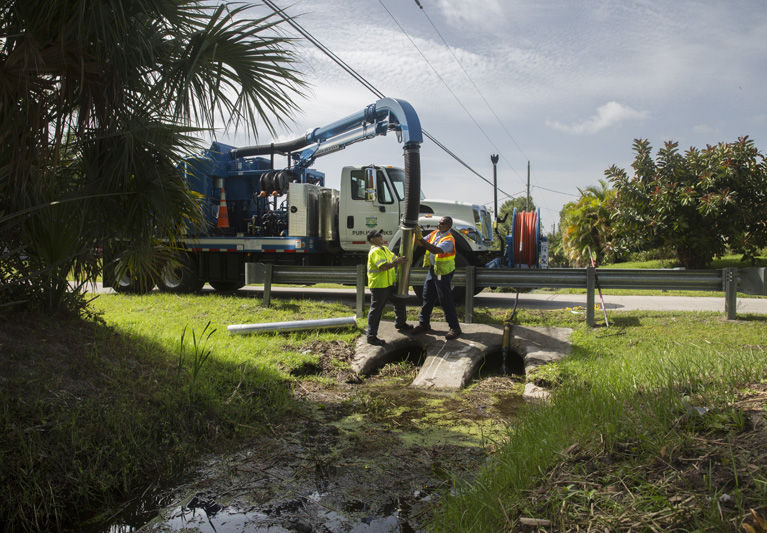
SEBASTIAN — Monday through Friday, city crews and contractors are hard at it, deployed along Sebastian’s 50-plus miles of drainage ditches, working in a concerted effort to solve the city’s long-standing drainage problems.
Rather than a reactive, as-needed patchwork approach, city staff has crafted a detailed schedule of work, starting in the northern ditch section, then the southern, responding to single residences only in emergency conditions.
The well-being of Sebastian’s residents, city infrastructure and the lagoon are affected by the woefully ineffective drainage system, rendered virtually useless by years of accumulated debris.
For these reasons, the city takes drainage issues very seriously and is putting its money and its manpower “where its mouth is.”
When Joe Griffin became city manager in April, solving the drainage problem was already high on his To Do List.
At that time, city staff had already divided the drainage system into 25 segments and had begun to replace the hundreds of miles of quarter round, segment by segment.
By then, however, it was painfully obvious that the main ditches needed immediate attention.
Hurricanes and the recession had seriously exacerbated the problem.
In December, after completing an underway quarter round segment, Griffin and staff “strategically delayed” the remaining quarter round work to concentrate on clearing the big ditches.
Several scheduled street repaving projects would have to wait, as well.
“Repaving is all for naught if we can’t get the water off,” Griffin and Public Works Director/City Engineer Frank Watanabe told City Council last fall, as many residents dealt as best they could with standing water after recent multi-day deluges.
Additional maintenance workers were hired, and replacement backhoes were purchased.
The new “crown jewel” of the drainage system maintenance fleet is an impressive, 20-ton VAC truck that cost the city $361,000.
The built-to-order vehicle, which arrived in June, replaces a dilapidated, 12-year-old VAC truck that was held together by spit and duct tape and spent more time in the shop than on the job.
Vegetation has been removed along 22.7 miles of the Northern Ditch system and 26 miles of ditch flow line; some 78,000 cubic yards of debris have been hauled off.
Currently public works is cleaning southern section ditches. In June, a second Public Works crew was deployed to continue the northern operation and a third crew will stand ready to be deployed citywide in a heavy rain event.
Watanabe anticipates another full year of citywide ditch cleaning to clear the backlog.
Earlier this month, a Sebastian River News team accompanied Supervisor of Roads and Drains Bub Milon to the ditch that crosses Doctor Avenue just past Roseland Road, where he and Bill Curry, who worked together on the old truck, were taking the new one on its first outing.
The task: cleaning the clogging debris from the mucky bottom of the ditch culvert crossing under Doctor, where the water was not flowing at all.
Those who like heavy equipment would be impressed with the shiny, spotless, blue and silver beast that Milon says is “so worth it.”
It carries 300 gallons of water, which can be sprayed out through one of several special nozzles, at a clog-busting 2,000 PSI, 80 gallons per minute.
As the water stream dislodges the clog, the powerful vacuum, attached to a moveable arm extending from the top of the truck, connected to segments of pipe, slurps up the debris into an 11 cubic-yard holding tank.
Depending on the task at hand, various pipes are attached to the vacuum, from 12” to 36” in diameter.
The water sprayer and vacuum are controlled from an instrument panel attached to the front of the truck.
From the truck’s port side, Curry hoisted out the pipe segments, 18-inchers for this job. While he attached them to the vacuum hose with clamps, Milon adjusted the controls.
Feet planted at the edge of the ditch, Curry guided the vacuum pipe down into the smelly water, and placed the water hose.
Milon turned on the spray and the vacuum.
After a few adjustments, the spray was stirring up the water and the vacuum was pulling the vegetative debris back into the truck’s holding tank. Soon, the ditch water began to circulate and then to flow freely.
Curry used a hand rake to drag some floating debris to the ditch bank.
As they worked, a guy from one of the city’s ditch cleaning contractors drove up on a tractor to check on the morning’s schedule.
At one point, a nearby resident bumped over in a golf cart to see what was going on and point out a pile of ditch debris in his yard that the cleaning crew had not yet picked up.
“That happens a lot,” says Milon with a grin. “I always try to be polite and explain what’s going on.”
The problem did not develop overnight, nor can it be corrected overnight. Watanabe has promised “to hit it from all directions,” and that’s just what’s happening.
But, like painting the Golden Gate Bridge, maintaining Sebastian’s vital drainage system is an ongoing job – one the City is determined to stay on top of.



